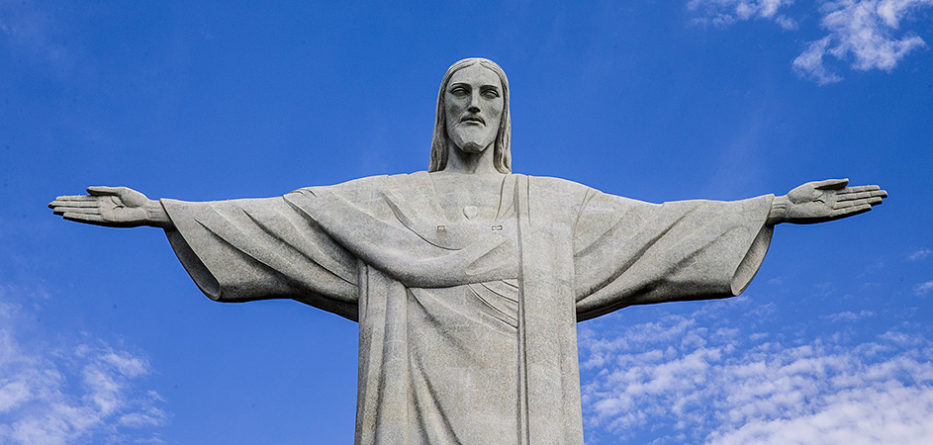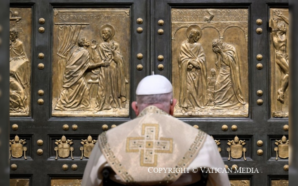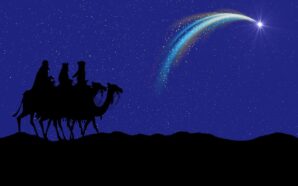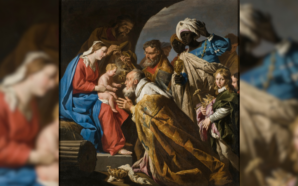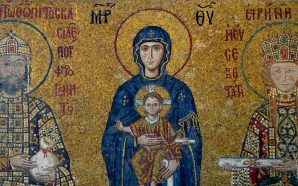The complex presentation of the origins of Jesus in the books of the Gospel embodies a tension between continuity and rupture, old and new, expectation and surprise in the life, death and resurrection of Jesus Christ. Two places, Nazareth and Bethlehem, characterise this tension that is fundamental to the relationship between the two covenants, whose unity forms the basis of the Christian Bible.
The perspective of Mark
Mark, the first of the Gospel accounts to be written, informs his readers right from the first verse who Jesus actually is: “the Messiah, the Son of God” (Mark 1:1). However, the author first introduces Jesus in the narrative account as coming to the Jordan for baptism from Nazareth. The informed reader is aware of the scandal involved in this presentation of Jesus: “In those days Jesus came from Nazareth of Galilee and was baptised by John in the Jordan” (Mark 1:9). Nazareth itself is never mentioned in the Scriptures of Israel. Therefore Nazareth “ought not” to be the place from which the long-awaited Messiah and Son of God emerges. Nazareth in Mark’s narrative is equivalent to “nowhere,” a place that does not resound with any echoes whatsoever of the great story of salvation and is utterly unconnected to the hope for the appearance of a Davidic Messiah.
While Jerusalem and Bethlehem embody the centre of a sacred geography in the midst of which salvation history unfolds – recognisable for its heritage, and pregnant with promise – Nazareth is like a barren wilderness, evoking no expectation at all. However, Nazareth, a word which appears nowhere in the Old Testament, plays an important role as it, as the place of origin, prepares the reader for the finality of the narrative, another word that never appears in the Old Testament: the Cross.
Nazareth marks Jesus’ point of departure as he sets off for the Jordan. It is on the banks of the Jordan that Jesus will give evidence for the first time that he has come to “empty himself.” It is Paul, Mark’s great teacher, who poetically reports the reality of Christ’s self-emptying: “Though he was in the form of God, he did not regard equality with God as something to be exploited, but emptied himself, taking the form of a slave, being born in human likeness. And being found in human form, he humbled himself and became obedient to the point of death, even death on a cross” (Phil 2:6-8).
Nazareth and the Cross constitute a beginning point and an endpoint of a process that begins to unfold at the Jordan. Jesus comes to be baptised by John (though Jesus is the greater), among the masses who are confessing their sins (though he is without sin). Jesus is coming from “nowhere” and he is heading for “no place,” ultimately hoisted onto a cross by sinners. As Paul thunderously proclaims: “We proclaim Christ crucified, a stumbling block to Jews and foolishness to Gentiles, but to those who are the called, both Jews and Greeks, Christ the power of God and the wisdom of God. For God’s foolishness is wiser than human wisdom, and God’s weakness is stronger than human strength” (1 Cor 1:23-25).
In Mark’s Gospel, the reader encounters Jesus only once in Nazareth, where, in the face of rejection, Jesus is “amazed at their unbelief” (Mark 6:6). Mark, again underlining the process of self-emptying, boldly writes: “He could do no deed of power there” (Mark 6:5) – indeed, he “could not.” The reader is offered an all-powerful Messiah and Son of God reduced to impotence because of the lack of faith of those who will soon actively oppose him.
For Mark, Nazareth prepares the reader for the Cross, representing a “tear” in the fabric of the promises in the Old Testament, a new and unexpected beginning. This is like the “tear” in the heavens when Jesus emerges from the water of the Jordan (cf. Mark 1:10) and the tear in the veil of the Temple when Jesus dies on the Cross (cf. Mark 15:38). What is old, trusted and known, even the expectation of a glorious Messiah, must tear in order to make place for the new, a Messiah and Son of God who passes through rejection, suffering, death and burial.[1]
The perspective of John
John, in his Gospel, echoes the Gospel of Mark in some ways. This is true, for example, when it comes to “Nazareth.” Nazareth appears twice in the first chapter of John. The narrative makes explicit the surprise regarding Jesus’ origins in Nazareth when Nathanael questions Philip about his claim that the one “about whom Moses in the law and also the prophets wrote” (John 1:45) is “Jesus, son of Joseph, from Nazareth.” Nathanael responds with disbelief: “Can anything good come out of Nazareth?” (John 1:45).
Furthermore, later in the Gospel of John, when some identify Jesus as the Messiah, others respond: “Surely the Messiah does not come from Galilee, does he? Has not the scripture said that the Messiah is descended from David and comes from Bethlehem, the village where David lived?” (John 7:41-42). This tear in the expectations embodied in the Scriptures of Israel leads to “a division in the crowd because of him” (John 7:43).
The perspective of Matthew
Matthew, despite his heavy reliance on Mark’s narrative, retrieves the Scriptural tradition, placing the birth of the Messiah in Bethlehem. He describes the three sages from the East who come to adore the child “after Jesus was born in Bethlehem of Judea” (Matt 2:1). Before the king, Herod, they ask their provocative question: “Where is the child who has been born king of the Jews?” (Matt 2:2). Herod, frightened by this proclamation of the arrival of a competitor, summons his own wise men, the chief priests and scribes, and they identify the place by referring to the Scriptures of Israel: “And you, Bethlehem, in the land of Judah, are by no means least among the rulers of Judah; for from you shall come a ruler who is to shepherd my people Israel” (Matt 2:6 quoting Mic 5:3).
Despite Matthew’s extensive reliance on Mark’s narrative, he is not always in agreement with Mark’s perspective and insists on a hermeneutic of continuity rather than one of rupture, one of fulfilment of promise rather than shocking surprise. Matthew’s focus on Joseph as the model of a righteous person is the sign of that continuity. Joseph, the paterfamilias, represents fulfilment of the promises contained in Scripture. And Bethlehem, the city of David, is not only the place where the Messiah is expected to be born, it represents a significant place in the long history of the people – a place where darkness and light have alternated through the long centuries of the march toward salvation.
The alternation of light and darkness in the life of David is well known, making him one of the most complex figures in the Old Testament. This alternation also marks the town in which he is born. In the last five chapters of the Book of Judges, Bethlehem features as a source of much evil, from where idolatry (an idolatrous Levite, cf. Judg 17:9-13) and lust (a sought after and murdered concubine, cf. Judg 19:1) emerge, leading to violence and civil war.
The darkness that dominates Bethlehem invades the entire land and would only be dissolved by the light brought to Bethlehem by the Moabite woman Ruth, herself representing a surprise. Although Moabites are excluded in perpetuity from the people of God according to the Law (cf. Deut 23:3), Ruth (like Abraham), leaves her homeland, tribe and father’s house to live in Bethlehem, bringing her light with her, becoming a model of faith in Israel.
When, after fleeing to Egypt and returning to Palestine from there, Joseph does settle the family in Nazareth, Matthew will insist on continuity even there: “There he made his home in a town called Nazareth, so that what had been spoken through the prophets might be fulfilled, ‘He will be called a Nazorean’” (Matt 2:23). The attempts to find the Scriptural citation that Matthew is referring to have been largely unsatisfactory. The fifth Old Testament citation in Matthew’s first two chapters remains a major unresolved exegetical problem.[2] Although Matthew claims to be citing the prophets, there seems to be no Scriptural text that corresponds to Matthew’s prophetic text. However, whereas the other four citations (cf. Isa 7:14 in Matt 1:23; Mic 5:3 in Matt 2:6; Hos 11:1 in Matt 2:15; and Jer 31:15 in Matt 2:18) are attributed to “a prophet,” the words “he will be called a Nazorean” are attributed to “the prophets.” Does Matthew mean many prophets or all the prophets? And where is this reference?
I would suggest that the use of the plural “prophets” implies going beyond the search for a single citation that corresponds to the words Matthew reports. Matthew is pre-eminently aware that the prophets of Israel bear witness to God, who can bring life out of nothingness, can turn the wilderness into a garden, can raise an entire people from the tomb. In the genealogy with which he opens his narrative, only one event is mentioned in the history of the people of Israel. This is the event of the Exile. “Josiah, the father of Jechoniah, and his brothers, at the time of the deportation to Babylon” (Matt 1:11). Matthew has read the prophets and meditated on their message: sin leads to death and the death of the people is the Exile in Babylon.
The reader is invited to pause at that point in the genealogy and recognise the enormity of the catastrophe. However, God will not let death have the last word and so the genealogy surges on: “And after the deportation to Babylon: Jechoniah was the father of Salathiel, and Salathiel, the father of Zerubbabel” (Matt 1:12). The words “and after” signify the stunning surprise that there is an “after,” that death does not have the last word. It was this that all the prophets taught: God will not abandon the people to death because despite their faithlessness, God is faithful forever. Even out of the “nothingness” of Exile, God will bring forth new life, a remnant that will return to Jerusalem to begin again.
It was in the light of this confidence that God will not let the “nothingness” of death prevail, that the first Priestly creation story was written. “In the beginning when God created the heavens and the earth, the earth was tohu wawohu (translated as ‘formless void’) and darkness covered the face of the deep, while a wind from God swept over the face of the waters. Then God said, ‘Let there be light’; and there was light” (Gen 1:1-3). Tohu (cf. Deut 32:10, Job 6:18, Ps 107:40, Isa 24:10, 34:11, 45:18.19, Jer 4:23) and bohu (cf. Isa 34:11, Jer 4:23) are synonyms for “wilderness” in Biblical Hebrew, the place where the conditions for life – food, water, clothing, shelter from serpents and scorpions – do not exist. In this sense Nazareth can be understood as a parallel to the “tohu wawohu” out of which God brings forth all of creation. Only God can transform “tohu wawohu” into the place of origin for the Jesus who emerges as the surprising fulfilment of the promises of God. “All” the prophets indeed confirm that out of nothingness God can create everything. God is then also at work both in Nazareth and at the Cross.
The perspective of Luke
However, it is Luke who turns Nazareth into a high place of revelation. Mary, the mother of Jesus, named for her predecessor “Mary (Miriam) the prophetess, sister of Aaron” (Exod 15:20), is also a prophetess of God. She receives the Word in Nazareth, and it is this that transforms Nazareth into a place as significant as Bethlehem. Luke’s narrative inserts Nazareth into the high places of the history of salvation. After all, if God could appear to the people of Israel at Sinai, a place outside the borders of the Land promised to the Fathers, if he could continue to speak to his prophets even in Babylon during the Exile, then, undoubtedly, he could send his holy angel to a virgin in Nazareth. Nazareth is as yet unsown with the seed of revelation, just like Mary’s womb is unsown by the seed of procreation. Yet “nothing will be impossible to God” (Luke 1:38).
In fact, Luke takes this a step further. Nazareth is presented as even greater than Jerusalem, a new locus of revelation. Just as Mary, a young woman from the margins, an unheard-of village, Nazareth, outshines Zachariah, an old man, a priest from the epicentre, the Temple in Jerusalem, so too does the revelation to Mary outshine the revelation to Zachariah. In a certain sense, Nazareth outshines Jerusalem as the origin of Jesus just as Antioch will outshine Jerusalem in the fruit garnered by Jesus’s life, death and resurrection. It is in Antioch that the model community, the communion of Jews and Gentiles, is formed, and there “that the disciples were first called ‘Christians’” (Acts 11:26).
Yet Luke does not abandon Bethlehem and Jerusalem. They retain their preeminent place, the old alongside the new. In Bethlehem, Mary, the prophetess, will place her newborn son in a manger, pointing to the fact that he will offer himself as bread for a hungry world. Forty days later, she and her spouse bring him for the first time into the Temple, where he will be recognised as “a light for revelation to the Gentiles and for glory to your people Israel” (Luke 2:32).
Nazareth and Bethlehem, old and new, rupture and continuity, rootlessness and rootedness, expectation and surprise, these opposites, with all the tensions they imply, are necessarily held together in order for us to encounter Jesus Christ, the Son of God, and to come to know more deeply the surprising fulfilment of the promises of God in him.
David Neuhaus, SJ is a Professor at the Pontifical Biblical Institute in Jerusalem.
Reproduced with permission from La Civiltà Cattolica.
DOI: La Civiltà Cattolica, En. Ed. Vol. 3, no. 2, article 1, Jan. 2019: 10.32009/22072446.1902.1
[1] In addition to the tearing of the heavens and the tearing of the veil of the Temple, Mark uses the noun “tear” once in a parable: “No one sews a piece of unshrunk cloth on an old cloak; otherwise, the patch pulls away from it, the new from the old, and a worse tear is made” (Mark 2:21). Here too he is underlining a rupture in the relationship of the new to the old.
[2] For a study of the different solutions proposed to resolve this crux see M. Menken, Matthew’s Bible: The Old Testament Text of the Evangelist, Leuven, Peeters, 2004, 161-177.




